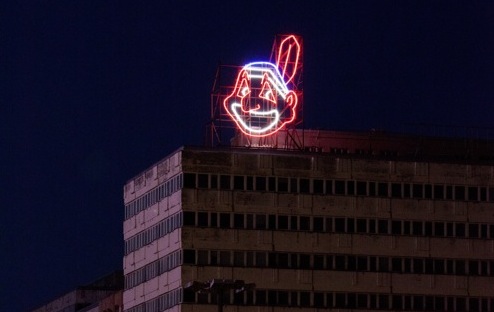An Indian in Berlin

Saturday evening, near Alexanderplatz: The face of a grinning Indian in neon floats above the soon-to-be-demolished Haus der Statistik on Otto-Braun-Straße. Is this some kind of joke?
Not at all – in fact, French artist Cyprien Gaillard has been at work here. Anyone familiar with the winner of this year’s Nationalgalerie Prize knows that he has already depicted this Indian several times. This location, a dreary pre-fab concrete structure from the Socialist era, is a particularly effective one for the installation.
A caricature of Native Americans
Simply stated, symbols of socialism and capitalism, two social systems showing the ravages of time, collide here. In the 1960s, the Haus der Statistik epitomized the pioneers of Socialist urban planning; today it’s nothing more than a sad relic. Gaillard’s 1950s-style Neon Indian proves to be equally incongruous, a caricature of Native Americans in the national colors of the US. Although it supposedly blends in with the illuminated advertising in the vicinity, it is unmistakably old-fashioned in appearance and serves no promotional function.
Gaillard considers himself a kind of archaeoligist
It’s probably no coincidence that Neon Indian brings Steven Spielberg’s Indiana Jones to mind. The character was an archaeologist in search of historical relics. Cyprien Gaillard considers himself a kind of archaeologist as well, exploring the urban landscape and passionately searching for vestiges of post-war modernist architecture. How has it been preserved, destroyed or re-constructed? To what extent does the passage of time reveal the lapses of the urban planners of yesteryear? In what form do socio-cultural symbols survive if the context changes?
A monument of mortality
If the pre-fab concrete structure on Otto-Braun-Straße is an obvious stand-in for the failure of the socialist social system, then the Indian is a similar reminder of the genocide of Native Americans. Ironically, this image is used by a US baseball team as its logo and good luck charm. Is this reinterpretation of a symbol at the expense of minorities?
Against this backdrop, building and artwork unite to form a monument of mortality in an implacably changing time. But in the end, there’s that grin on the face of the Indian. Is it one of tragedy, joy or triumph? That’s the question.
On display until December 11, 2011.
Cyprien Gaillard is represented by the Gallery Sprüth Magers. The Neon Indian is part of The-Artists-in-Berlin-Programme DAAD, in collaboration with “based in Berlin” and supported by Institut Français Berlin.
Be the first to write a comment.
Your feedback
